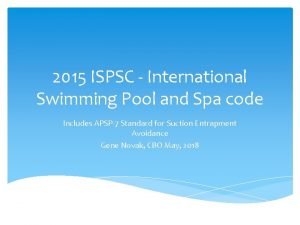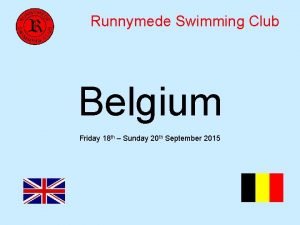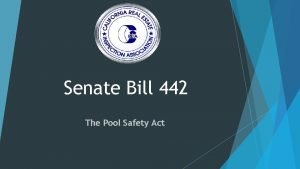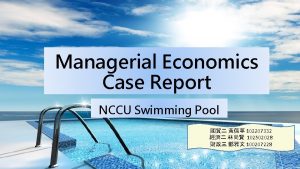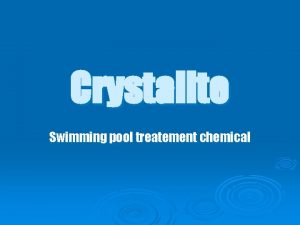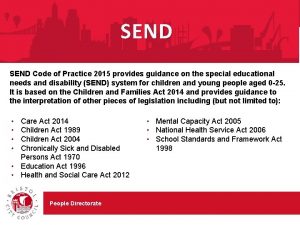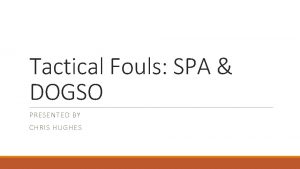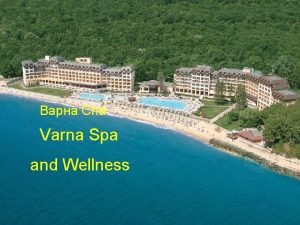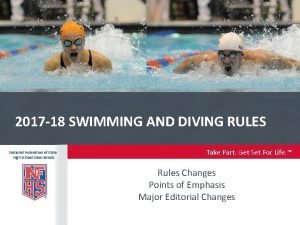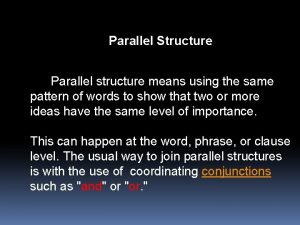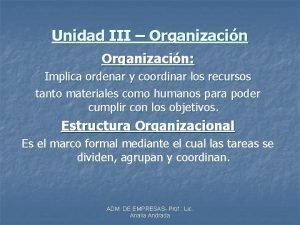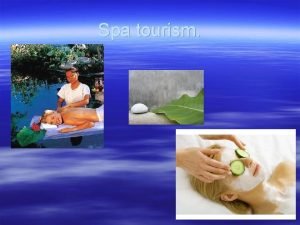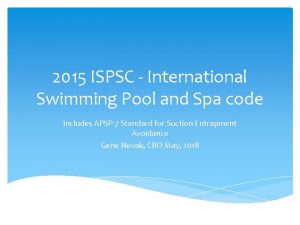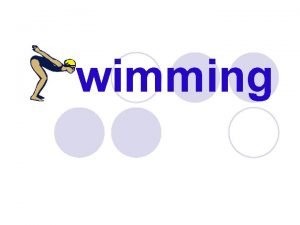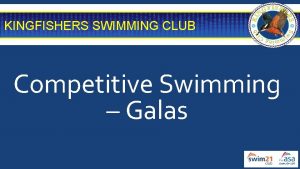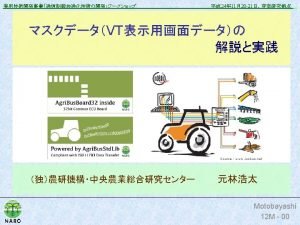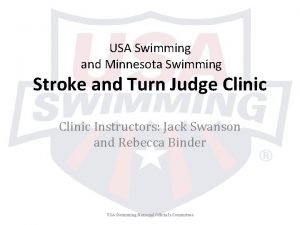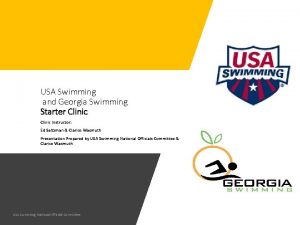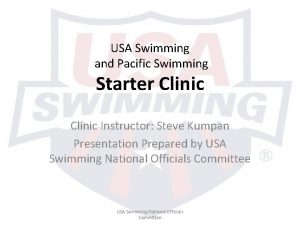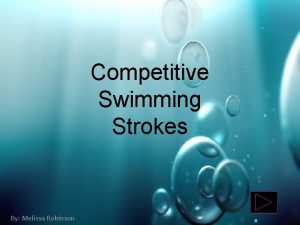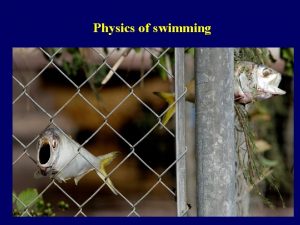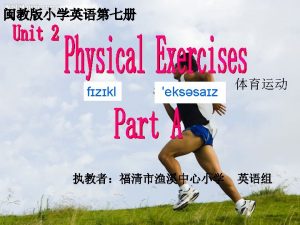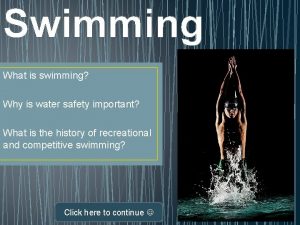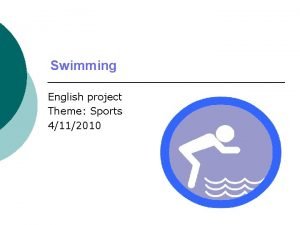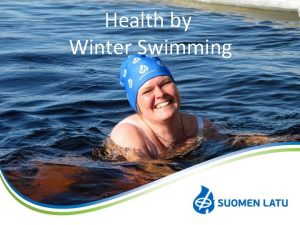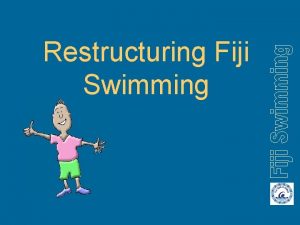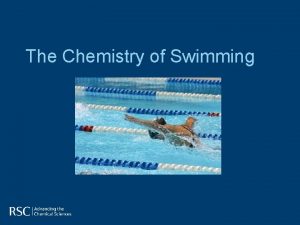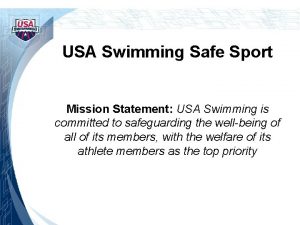2015 ISPSC International Swimming Pool and Spa code



































- Slides: 35

2015 ISPSC - International Swimming Pool and Spa code Includes APSP-7 Standard for Suction Entrapment Avoidance Gene Novak, CBO May, 2018

Disclaimer The following information is based on the materials that have been made available, like everything else in life, please confirm this information is in fact the latest and most up to date by reviewing the I-codes (printings/electronic copies) the Massachusetts Amendments and the Department’s website for the latest updates and confirmation of requirements…i. e. due diligence… The information is the opinion of the presenter and does not represent the BBRS, DPL, nor ICC. It is the user responsibility to confirm the latest up to date information.

APSP -7 The Association of Pool and Spa Professionals

Types of pools • Activity pools Diving Pools Interactive Lazy River Plunge Pools Runout slide Wading Pools Wave Pools Other pools Surf Pools

Float Tank - Not

ISPSC - 2015

MGL 140 Section 206 Prev Next CHAPTER 140 LICENSES Prev Next Section 206 Public and semipublic outdoor inground swimming pools; enclosures; safety equipment; inspection; violations; penalty Prev Section 206. Every public and semipublic outdoor inground swimming pool shall be enclosed by a fence six feet in height and firmly secured at ground level provided that any board or stockade fence or structure shall be at least five feet in height, but if over five feet in height, the fence shall be chain link. Such enclosure, including gates therein, shall not be less than six feet above the ground, and any gate shall be self-latching with latches placed four feet above the ground or otherwise made inaccessible from the outside to children up to eight years of age. Such enclosure shall be constructed of such material and maintained so as not to permit any opening in said enclosure, other than a gate, wider than three inches at any point along the enclosure. Any such pool shall be equipped with at least one life ring and a rescue hook. Every outdoor inground swimming pool open to the public, other than a public inground swimming pool fed by a spring or stream shall be drained or covered within seven days of closing. For the purposes of this section, ''semipublic outdoor inground pool'' shall mean a swimming or wading pool on the premises of, or used in connection with, a hotel, motel, trailer court, apartment house, country club, youth club, school, camp, or similar establishment where the primary purpose of the establishment is not the operation of the swimming facilities. Semipublic outdoor inground swimming pool shall also mean a pool constructed and maintained by groups for the purposes of providing bathing facilities for members and guests only. Every public and semipublic outdoor inground swimming pool shall be inspected annually by the inspector of buildings of each city and town in which said pool is located.



Latest Pool Safely Stats: At Least 163 Children Fatally Drowned in Pools and Spas This Summer September 18, 2017 Nearly 70% of These Drownings Involved Children Younger Than Age Five WASHINGTON – From Memorial Day through Labor Day 2017*, at least 163 children younger than age 15 fatally drowned in swimming pools or spas, according to media reports compiled by the USA Swimming Foundation, a Pool Safely campaign partner. Of the 163 reports, 112 of the victims — nearly 70 percent — were children younger than age five. During the same timeframe in 2016, 205 children younger than age 15 drowned in swimming pools or spas, according to media reports. Of the 205 reports, 140 of the victims — nearly 70 percent — were children younger than age five. “Each one of these deaths is a tragedy, which serves as a sobering reminder of how dangerous water can be for young children, ” said Ann Marie Buerkle, Acting Chairman, U. S. Consumer Product Safety Commission. “Even though summer is over and children are back in school, pools are still open in warm weather states and indoor swim parks. I encourage all families to Pool Safely and follow the simple steps that save lives whenever they’re enjoying time in or near the water. ” The following states suffered the highest number of pool and spa drownings involving children younger than 15 from Memorial Day through Labor Day 2017*: Florida: 25 California: 14 Texas: 14 Arizona: 10 Georgia: 7 Ohio: 7 Virginia: 7 Indiana: 6 Louisiana: 6 The Pool Safely campaign, a national public education campaign run by the U. S. Consumer Product Safety Commission (CPSC), provides information on the simple steps that parents, caregivers, and pool owners should take to ensure that children and adults stay safer in and around pools and spas in an effort to reduce fatal and nonfatal drownings. All parents and caregivers are reminded to follow Pool Safely’s simple steps to keep children safer in and around the water.


• Install a Water Watcher to supervise children at all times around the water. four-sided fence with a self-closing, self-latching gate around all pools and spas. • Designate an adult • Learn how to swim and teach your child how to swim. • Learn how to perform CPR on children and adults. • Teach children to stay away from pool drains, pipes and other openings to avoid entrapments. • Ensure any pool or spa you use has drain covers that comply with federal safety standards. If you do not know, ask your pool service provider about safer drain covers. • The Pool Safely campaign was launched in 2010 by the U. S. Consumer Product Safety Commission (CPSC) to raise awareness about pool and spa safety, as mandated by the Virginia Graeme Baker Pool and Spa Safety Act. • Visit Pool. Safely. gov/Pledge to take the Pledge to help prevent drownings. • *Dates defined as Saturday, May 27, 2017 through Monday, Sept. 4, 2017. • ###


Virginia Graeme Baker Pool & Spa Safety Act (P&SS Act) FAQ Q: What are public pool and spa owners/operators obligated to do to comply with the Virginia Graeme Baker Pool & Spa Safety Act (P&SS Act)? A: As of December 19, 2008, all operating public pools and spas must have drain covers that meet the ANSI/ASME A 112. 19. 8 -2007 standard on every drain/grate. In addition, if the pool has a single main drain (other than an unblockable drain), the operator must either disable the drain or install a second anti- entrapment device or system. This can take the form of an automatic shut-off system, gravity drainage system, Safety Vacuum Release System (SVRS) or suction-limiting vent system. A pool may have more than one single main drain. If a pool has dual or multiple main drains more than 3 feet apart, it may be exempt from this second requirement. Pools and spas with single main drains that are unblockable are also exempt from this requirement. (Last Updated: January 30, 2009)



Model Aquatic Health code 1. 2 Recreational Water-Associated Illness Outbreaks and Injuries 1. 2. 1 A RWI Outbreaks Large numbers of recreational water-related outbreaks are documented annually, which is a significant increase over the past several decades. 1. 2. 2 A Significance of Cryptosporidium causes a diarrheal disease spread from one person to another or, at AQUATIC VENUES, by ingestion of fecally-contaminated water. This pathogen is tolerant of CHLORINE and other halogen disinfectants. Cryptosporidium has emerged as the leading cause of POOL-associated outbreaks in the United States. 1. 2. 3 A Drowning and Injuries Drowning and falling, diving, POOL chemical use, and suction injuries continue to be major public health injuries associated with AQUATIC FACILITIES. Drowning is a leading cause of injury death for young children and a leading cause of unintentional injury death for people of all ages. 1. 2. 4 A Pool Chemical-Related Injuries POOL chemical-related injppuries occur regularly and can be prevented if POOL chemicals are stored and used as recommended.

Pool Safely WATER SAFETY STEPS STAY CLOSE, BE ALERT AND WATCH Always watch children and never leave them unattended Keep children away from pool drains, pipes and other openings Have a charged phone close by at all times If a child is missing, check the pool first Share safety instructions with family, friends and neighbors Even if a lifeguard is present, parents and caregivers should still take the responsibility of being a designated Water Watcher LEARN AND PRACTICE WATER SAFETY SKILLS Learn to swim and make sure kids do, too Know how to perform CPR on children and adults Understand the basics of life-saving so that you can assist in a pool emergency HAVE THE APPROPRIATE EQUIPMENT Install a fence of at least four feet in height around the perimeter of the pool or spa Use self-closing and self-latching gates Ensure all pools and spas have compliant drain covers Install an alarm on the door leading from the house to the pool Keep pool and spa covers in working order Have life-saving equipment such as life rings or reaching poles available for use

Chemicals Wetting: Under normal circumstances, pool chemicals are intended to be added to large quantities of water. If, instead, a limited volume (amount) of water is added to a chemical, an unwanted reaction may occur, resulting in an increase in temperature and the release of toxic gas. Even a small amount of water splashed on the chemical may in some cases trigger a strong reaction. The main exception to this rule concerning water addition is when very large quantities of water are needed for fire fighting, as discussed below. Although the chemicals are usually packaged in plastic bags that are stored in sturdy cartons or drums, accidents have occurred when water leaked into damaged or open containers

Design of Chemical Storage Area and Pump Room o Construction • Include spill containment features, also known as secondary containment, in chemical storage areas to prevent pool chemical leaks or spills from mixing with any other substances. • Provide aquatics staff and patrons with easily accessible safety showers, eye wash stations, and other appropriate chemical safety equipment. • Install appropriate fire suppression equipment. − Consult with local fire department or code enforcement agency for guidance. • Provide adequate lighting for reading labels on containers throughout the chemical storage area and pump room. o Air handling (for indoor pools) • Follow local building codes and/or American Society of Heating, Refrigerating and Air. Conditioning Engineers (ASHRAE) Standards. − Separate the air handling systems for the chemical storage area and pump room from the rest of the building. − Separate the air handling system for the pool area from the rest of the building. − If an older aquatic facility does not have separate air handling systems for the chemical storage area and pump room as well as the pool area, consider installing emergency heating, ventilating, and air conditioning (HVAC) cutoffs in these areas. • Ensure that the chemical storage area and pump room as well as the pool area are well ventilated. • Ventilate the chemical storage area, pump room, and pool area to the outside. o Engineering • Install an alarm to alert the aquatics staff if the recirculation pump shuts down. • Install a device that automatically deactivates the chlorine/p. H feed pumps when there is no flow in the recirculation system. • Install check valves in chemical feed lines. These valves allow chemicals (liquid or gas) to flow through only in one direction and stop suction events from causing an overfeeding of chemicals

Table 1 Recent Incidents Involving Swimming Pool Water Treatment Chemicals Month Year City State Brief Description of Incident Effect February 2000 Elizabethtown, Tennessee Fire and smoke from a storage facility that contained chemicals including swimming pool water treatment chemicals. The fire was in an area isolated from the pool chemicals, however particular precautions were taken to prevent the pool chemicals from becoming involved. Local school closed early to relieve traffic congestion; local residents advised to remain indoors. No injuries reported. October 1999 Avon, Indiana Fumes released from container of a strong acid that was being used to clean a high school swimming pool. School evacuated. No injuries reported. August 1999 Burlington, New Jersey A pallet containing 400 lbs of calcium hypochlorite spilled at a warehouse. The spill was caused by the corrosion of steel shelving on which the material was stored. The spilled material mixed with other incompatible materials, resulting in fire and release of products of combustion and decomposition including chlorine gas. Five warehouse workers were hospitalized from the toxic gas exposure. Twenty-four others were treated and released. August 1999 Bergen County, New Jersey Granular chlorinating material, similar to that used for swimming pool water treatment, spilled while moving a container in a warehouse. Released vapors sent 28 government workers to area hospitals. July 1999 Richmond, Virginia Chemical exploded as it was prepared for release into apartment complex pool. One employee injured. June 1999 Cleveland, Ohio Toxic fumes released at local community center swimming pool, when pool water chemicals including muriatic acid were inadvertently mixed. Two fire fighters and two others injured and area evacuated. February 1999 Fort Worth, Texas Fire, smoke and vapors released from large warehouse containing pool chemicals and other materials. The cause of the fire was not reported. Warehouse destroyed. No injuries reported; residents told to remain indoors. December 1998 Auburn, New Hampshire Small explosion and vapors were released when about a cup of swimming pool chemical was improperly disposed of at a regional waste treatment station. Four minor injuries. Waste treatment station shut down.

Diving Envelope

CDC - MAHC Model Aquatic Health Code www. cdc. gov

This page summarizes the data that led to CDC creating the MAHC. Swimming and other water-related activities(https: //www. cdc. gov/healthywater/swimming/swimmers/health_benefits_water_exercise. html) are excellent ways to get the physical activity and health benefits needed for a healthy life. Americans swim hundreds of millions of times in pools, oceans, lakes, rivers, and hot tubs/spas each year 1 and most people have a safe and healthy time enjoying the water. However, outbreaks of recreational water illnesses(https: //www. cdc. gov/healthywater/swimming/ swimmers/rwi. html) (RWIs) have increased significantly over the last several decades 2 and drowning and neardrowning(https: //www. cdc. gov/healthywater/swimming/swimmers/drowning-injury-sun-protection. html) 3 -6 and pool-related chemical injuries(https: //www. cdc. gov/healthywater/swimming/aquatics-professionals/preventing-pool-chemical-events. html) 7 -12 continue to occur. This makes it important that public pools and spas are designed, constructed, operated, and inspected to keep swimmers healthy and safe. Resources Frequently Asked Questions for Potential MAHC Users(https: //www. cdc. gov/mahc/faqs. html) Fact Sheets(https: //www. cdc. gov/mahc/fact-sheets. html) Infographic(https: //www. cdc. gov/mahc/infographics. html) In the United States, there is no federal regulatory agency that regulates aquatic facilities so public pools and spas are regulated at the state or local government level. To assist state and local agencies, CDC has led a national collaborative effort with public health, industry, and academic partners from across the United States to develop a national guidance document, called the Model Aquatic Health Code (MAHC), to prevent drowning, injuries, and the spread of recreational water illnesses at public swimming pools and spas. The MAHC integrates the latest knowledge based on science and best practices with specific code language and explanatory materials covering the design, construction, operation, and maintenance of swimming pools, spas, hot tubs, and other public disinfected aquatic facilities.

105 CMR: DEPARTMENT OF PUBLIC HEALTH

Water slides

Spray Pads

Competition type pools Activity Areas

Safety Equipment

Shunt Switch/Emergency Shut-off

Chemical Feeders

Signage


MAHC – Model Aquatic Health Code Free download at: www. cdc. gov Certifications: WWW. NSPF. ORG.

Handouts: email to MWBOA 1. Presentations 2015 ICC - ISPSC 2. Chemical Storage Handling 3. MAHC - link
 2015 ispsc
2015 ispsc Ecu pool
Ecu pool Commonwealth swimming pool
Commonwealth swimming pool Sai kung swimming pool
Sai kung swimming pool The orphaned swimming pool analysis
The orphaned swimming pool analysis Eastwood heights swimming pool
Eastwood heights swimming pool Runnymede pool
Runnymede pool Lifeguard emergency action plan
Lifeguard emergency action plan California swimming pool safety act 1998
California swimming pool safety act 1998 Nccu pool
Nccu pool Swimming pool
Swimming pool Gurnell skatepark
Gurnell skatepark Tadcaster swimming pool timetable
Tadcaster swimming pool timetable Code commit code build code deploy
Code commit code build code deploy Code of practice 2015
Code of practice 2015 Section 507 of the 2015 minnesota residential building code
Section 507 of the 2015 minnesota residential building code Spa vs dogso
Spa vs dogso Varna spa
Varna spa Bali relaxing resort & spa
Bali relaxing resort & spa Dolce salon and spa
Dolce salon and spa They all day swimming and sunbathing at the beach
They all day swimming and sunbathing at the beach Parallel structure means
Parallel structure means Parallel structure
Parallel structure Nfhs swimming and diving rules book
Nfhs swimming and diving rules book Parallel structure def
Parallel structure def Mary likes hiking swimming and cycling
Mary likes hiking swimming and cycling Same pattern words
Same pattern words Mary likes hiking swimming and cycling
Mary likes hiking swimming and cycling Organigrama de un spa
Organigrama de un spa Peter zumthor bath
Peter zumthor bath Ribarska banja smestaj vila hercegovina
Ribarska banja smestaj vila hercegovina Meaning of spa in tourism
Meaning of spa in tourism Siemens sepac
Siemens sepac Radenci spa resort
Radenci spa resort Single point of access hillingdon
Single point of access hillingdon Pudding lab
Pudding lab
